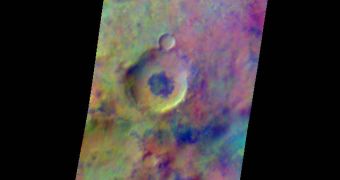Launched way back on April 7th, 2001, NASA's Mars Odyssey orbiter has been circling the Red Planet since October 24th, 2001, and has been providing the American space agency, and humankind in general, with incredible amounts of data about the composition of the Martian soil, as well as with images of the planet's surface, taken with its three primary instruments. Recently, officials at the agency announced that the craft successfully managed to complete an eight-month adjustment process, which brought it in an orbit that allows the orbiter to move over the day-side of the planet at around 3:45 in the afternoon, rather than at 5, as usual.
The procedure was conducted because, the sooner after midday the craft passed over the land, the more light was reflected from the ground, and captured by its Thermal Emission Imaging System (THEMIS) camera. In addition to this instrument, the orbiter also has the Gamma Ray Spectrometer (GRS) – which includes the Russian-built High Energy Neutron Detector (HEND), as well as the Mars Radiation Environment Experiment (MARIE). Among the most important discoveries that these instruments made, scientists highlighted the large amounts of hydrogen the GRS picked up as coming from less than one meter under the Martian soil, which means that ice is buried under a thin layer of sand.
“The orbiter is now overhead at about 3:45 in the afternoon instead of 5 pm, so the ground is warmer and there is more thermal energy for the camera’s infrared sensors to detect,” Jet Propulsion Laboratory (JPL) expert Jeffrey Plaut, from the NASA facility headquarters, in Pasadena, California, explains. He is also the project scientist for the Mars Odyssey mission. “The new orbit means we can now get the type of high-quality data for the rest of Mars that we got for 10 or 20 percent of the planet during those early six months,” the Thermal Emission Imaging System principal investigator, Philip Christensen, currently at the Arizona State University in Tempe, adds.
Until this maneuver, the craft was locked in a position that was a compromise between the best observing positions for its three instruments. However, it would appear that the infrared imager was a lot more important than the others, so engineers decided to modify the orbiter's path around Mars. The decision was made soon after the mission was extended one more time, so as to maximize the science benefits experts derived from it.

 14 DAY TRIAL //
14 DAY TRIAL //